GREENWICH VILLAGE MOVES TO BROOKLYN (1921)
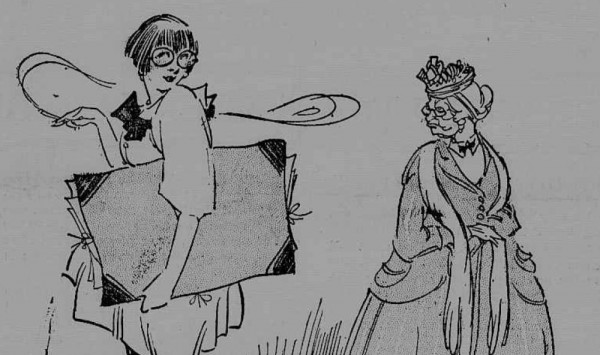
******************************************************************************************************************************** Brownstone Detectives investigates the history of our clients’ homes. The story you are about to read was composed from research conducted in the course of one of those investigations. Do you know the history of YOUR house? ******************************************************************************************************************************** “Greenwich Village is moving to Brooklyn. No, there isn’t a catch in it. It’s so.” So began the cover story of Magazine and Book section of the New York Sun from Sunday, 24 April 1921. “The new site of village activities,” the article explained, “was Brooklyn Heights.” And hair was short. It could have easily been 2017. THE BOHEMIAN LIFE OF BROOKLYN HEIGHTS The story, written by Hannah Mitchell – who would later become the editor of The Scarsdale Inquirer – took on the aura of the modern day true-life story associated with the small-town girl who’s moved to New York City in the past 5-10 years, and, finding she could not afford it – because she could not – had determined she would swallow her pride and halve her rent by moving to Bushwick, thus living (and defending) the bohemian life. Mitchell, who justified her move to Brooklyn Heights as just a slide over to another Greenwich Village with benefits, ballyhooed the pros of the Brooklyn Heights apartment and how it far surpassed that of the Greenwich Village. “From the outside these places are made attractive by little painted panels, frescoes over the doorways, and other quasi-exotic decoration,” Mitchell explained. “Inside they have the virtue of being freshly plastered and […]
THE CHANGING FACE OF A STOOP (1921)
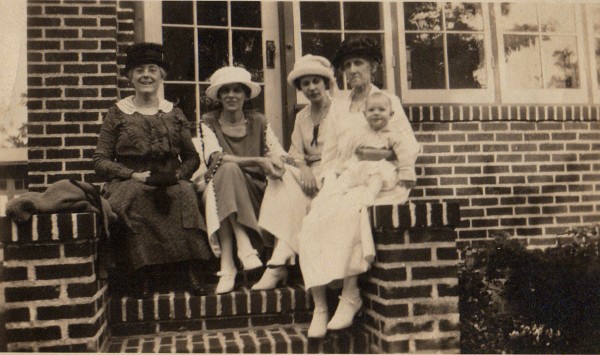
******************************************************************************************************************************** Brownstone Detectives investigates the history of our clients’ homes. The story you are about to read was composed from research conducted in the course of one of those investigations. Do you know the history of YOUR house? ******************************************************************************************************************************** In 1921, the Nilsen family purchased their Bay Ridge home at 8719 Colonial Road. Immediately, it seems, they began to document a lifelong record of their family’s generations, all surrounding one of the more iconic features attached to a Brooklyn home – their stoop. With a fascinating collection of photographs arranged in a chronological order, Bonnie Nilsen – whose father, Frank, is in most of the photographs – laid out her family’s record of life on the stoop of the original Nilsen family home. (The original record – along with Bonnie’s other photographs – can be seen at her website, BonnieNilsen.com.) In the meantime, though, we’d like to share a few of the more “stoop-central” photographs below. (See if you can spot the changes over the years.) Follow @BrownstoneDetec Share ———————————————————————————————————————– The Brownstone Detectives Brownstone Detectives is an historic property research agency. Our mission is to document and save the histories of our clients’ homes. From our research, we produce our celebrated House History Books and House History Reports. Contact us today to begin discovering the history of your home.
THE SEVEN SISTERS OF LINCOLN PLACE (1906)
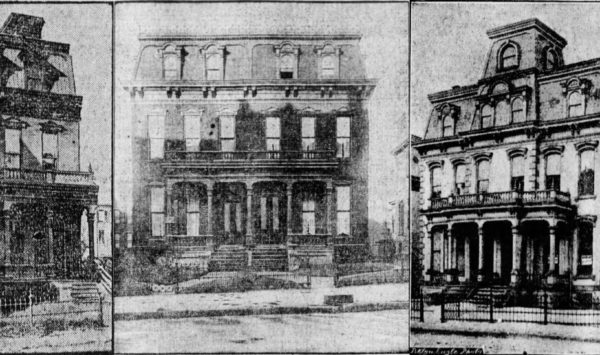
******************************************************************************************************************************** Brownstone Detectives investigates the history of our clients’ homes. The story you are about to read was composed from research conducted in the course of one of those investigations. Do you know the history of YOUR house? ******************************************************************************************************************************** If the Big Bad Wolf had had anything to do with it, he would have always voted for the predictability of a good detached wood-frame villa. It had gotten him far in his day and, what’s more, it had gotten him fed. But it wasn’t the Three Little Pigs’ hairy nemesis that was making housing decisions in Park Slope, Brooklyn around the turn of the last century. Rather, it was the Pigs, themselves, who wanted more modern, sturdier, up-to-date brick and masonry structures. THE DEATH OF VILLAS In early 20th century Brooklyn, a combination of home buyers’ indicators was guiding downward the valuation of older Victorian-era properties. First of all, impacting the long-term downward trajectory, there were the laws promoting fire zones that prevented structures built with wood frames from being constructed going forward. There was also their susceptibility to fire (which prompted these fire zones in the first place). And there was their age – a large number of free-standing villas still around in Brooklyn at the time were at least 25 years old – most others were many years older that that. Most visible, however, were the tastes of the early 20th century home buyers which leaned heavily in the direction of sturdy masonry buildings. The variable, however, which […]
FROM A TUDOR TO A BOX (1926)
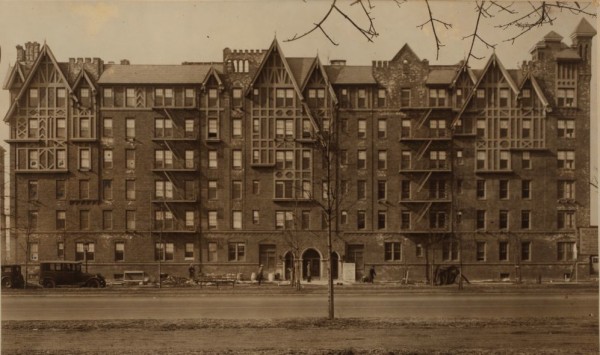
******************************************************************************************************************************** Brownstone Detectives investigates the history of our clients’ homes. The story you are about to read was composed from research conducted in the course of one of those investigations. Do you know the history of YOUR house? ******************************************************************************************************************************** It’s a given fact that we all age. It is not such a given that we all do it well. These impressive Tudor revival apartment houses were going up everywhere throughout the outer reaches of Brooklyn in the mid 1920s. The style was appealing to the Brooklynites of the Roaring ’20s, especially those who did not want the responsibility of the upkeep of a full house, had some money in their pocketbooks, and wanted a style of home that was not only visually appealing, but was also different from the stoic – and by then dated – townhouse. The “ultra modern elevator apartment house” at 1800 Ocean Parkway in Gravesend boasted an “ocean view” and apartments with cedar closets, a vapor heating system, tiled kitchens, spacious foyers, an incinerator, and selections of apartments with three, four, or five “huge” rooms each. They were renting for a princely $60 to $95 a month. No one, at the time, could have expected that these grand apartment houses would have aged so disgracefully. In this case, time has been particularly unkind. While this building may very well be structurally sound today, everything that had once made this building stand out from its neighbors – and contributed to its great “visual appeal” – has either […]
A BUFFALO SOLDIER ON HERKIMER ST. (1930)
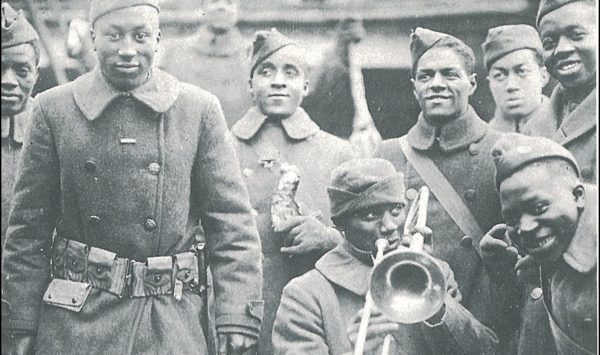
******************************************************************************************************************************** Brownstone Detectives investigates the history of our clients’ homes. The story you are about to read was composed from research conducted in the course of one of those investigations. Do you know the history of YOUR house? ******************************************************************************************************************************** It was 1918, and Harry Francis Cole had only three options. As an African-American in the United States, drafted into the military when the country was entering the First World War, he could: 1) work as a non-combatant – laboring as a stevedore, digging trenches, graves, and latrines, or building hospitals, roads, bridges, and railroad lines, 2) fight in a segregated unit – as an American soldier with the French Army, whose soldiers did not object to fighting alongside African-American troops, or 3) join a military band – one of the many brass bands in the European theater that were composed of African-American musicians. Cole, already a budding musician back home in Philadelphia, would naturally find himself in the last group, a horn player in one of the units of the 92nd Division – or, as the military unit was more commonly known, the venerated “Buffalo Soldiers.” BORN TO WAIL Born one of four children to William and Carrie Cole in Philadelphia in 1896, Harry Cole was never really destined to be a fighter. When he was a boy he was even then sure that his future was in music. He likely caught the bug when ragtime was all the craze, but when he heard the new sound of jazz in the […]
BROOKLYN’S PLAN TO SAVE DAYLIGHT (1917)

******************************************************************************************************************************** Brownstone Detectives investigates the history of our clients’ homes. The story you are about to read was composed from research conducted in the course of one of those investigations. Do you know the history of YOUR house? ******************************************************************************************************************************** It’s difficult to believe that just over 100 years ago there was opposition to Brooklyn’s plan to “save daylight.” But in 1917, when Brooklyn State Senator Calder was talking up his “Daylight Saving” idea, many future-opponents started, at that time, to smell (and prepare for) a fight. As such, when the bill was actually lodged the following year, these opponents of sunlight came out from the dark in full force with every reason NOT to have daylight saving – under the sun: (1.) The theaters would go out of business, as no one wants to attend while the sun is still shining. (2.) The Bible is opposed to it – read Joshua, chapter 10, where he fought the Amorites – during the battle of which God held the sun from going down for one hour – long enough for Joshua to win his battle. (3.) Too much sun is bad for us, claimed some doctors. (4.) Steamship and railway lines would suffer, as their adjusted timetables would confuse passengers. (5.) It violated Home Rule, said Governor Al Smith. The reasons were as endless as they were interesting. But just as the sun will rise tomorrow, so was it eventual that Daylight Saving would come. In the end, the measure won the […]
HALLOWEEN ON THE SUBWAY (1922)
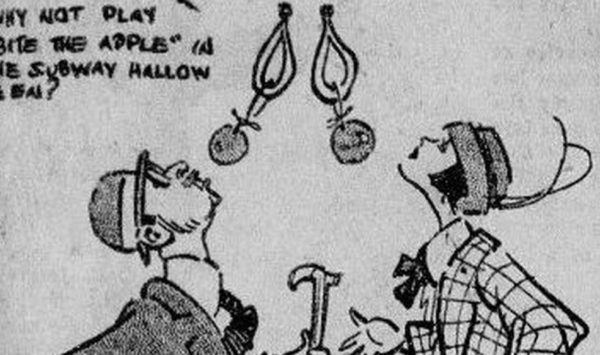
******************************************************************************************************************************** Brownstone Detectives investigates the history of our clients’ homes. The story you are about to read was composed from research conducted in the course of one of those investigations. Do you know the history of YOUR house? ******************************************************************************************************************************** Those of you who live in New York might have seen costumers on the subway during your commute today. It is less likely, though, that you saw straphangers bobbing for apples. At the time of this cartoon’s publication in the October 29th, 1922 edition of the New York Tribune, the subway was a mere 18-year-old. And the term “straphanger” was not much older – it derived from the (at first leather, and later metal) straps which hung from the ceiling of a street or subway car. “Why not play ‘bite the apple’ in the subway Halloween?”, shows two New Yorkers, a “dudish” man and an “artsy” woman (two typical subway riders of the day?) “bobbing” for apples from those straps. When was the last time you played this game??? Follow @BrownstoneDetec Share ———————————————————————————————————————– The Brownstone Detectives Brownstone Detectives is an historic property research agency. Our mission is to document and save the histories of our clients’ homes. From our research, we produce our celebrated House History Books and House History Reports. Contact us today to begin discovering the history of your home.
SHAKESPEARE AT NO. 24 BREVOORT PL (1928)
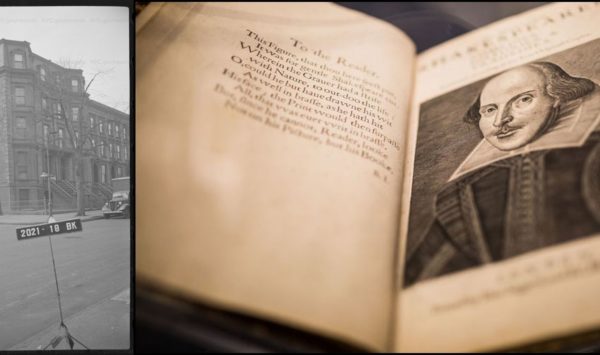
******************************************************************************************************************************** Brownstone Detectives investigates the history of its clients’ homes. The story you are about to read was composed from research conducted in the course of one of those investigations. ******************************************************************************************************************************** Henry C. Folger loved Shakespeare. His admiration for the author and his writings was such that he once paid $100K for a single folio of the bard’s work. The president of the Standard Oil Company was so smitten with Shakespeare’s works that, in 2014, a book, Collecting Shakespeare, was published about Folger and his collection. Folger, who started his relationship with Standard Oil as its director, would rise to become the chairman of its board, building a trusted relationship with the company’s owner, John D. Rockefeller, Sr. While frugal in the management of his money, Folger’s position with the largest oil company in the world certainly allowed him plenty of it to use in the pursuit of everything Shakespeare. And everything Shakespeare that he purchased for his collection eventually made its way to the library of their rented house at No. 24 Brevoort Place in Brooklyn, where the couple would live from 1910 through the early 1930s. FOLGER, BREVOORT, & SHAKESPEARE Henry Clay Folger’s collection of Shakespeareana included 35 copies of the 1623 first folio edition, of which only 200 copies were then known to be in existence. These earliest texts of William Shakespeare’s works were published during the 16th and 17th centuries in quarto or folio format. While quartos are smaller volumes, folios are large, tall volumes, roughly […]
WHEN BUSHWICK MET OCEAN HILL (1923)
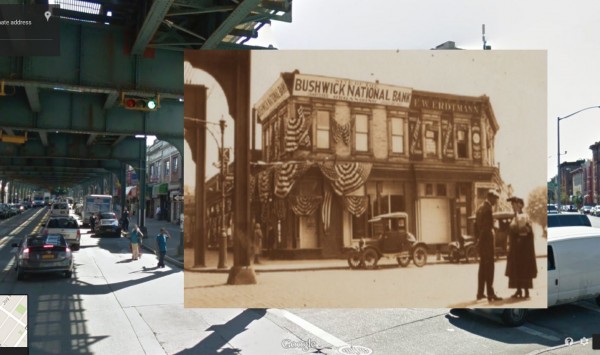
******************************************************************************************************************************** Brownstone Detectives investigates the history of our clients’ homes. The story you are about to read was composed from research conducted in the course of one of those investigations. Do you know the history of YOUR house? ******************************************************************************************************************************** “Ocean Hill” was still settling softly into the Brooklyn lexicon of place names as a working class suburb in 1923. Bushwick, on the other hand, was already very well-known in the borough for its German breweries and beer gardens. But where the two met – and they met, all right – there were SPARKS! (…or maybe a bank or real estate office….) This snapshot was taken at the intersection of Broadway and Hopkinson Avenue (later to be renamed Thomas S. Boyland Street). The building there on the corner in 1923 held the Bushwick National Bank and Frederick W. Erdtmann’s real estate offices. The Bushwick National Bank came into existence the same year that this photograph was taken – probably the reason for the photograph and the patriotic bunting all around the building; the bank ended up merging with the Globe Exchange Bank in 1929, and so had a short life of about six years. Frederick W. Erdtmann, a realtor who lived at 868 Macon Street and then above his real estate offices in this building, had filed for bankruptcy in 1913 before this photo was taken. He was back in the real estate business by 1919 and did well for himself in the 1920s. Who the old woman and the young […]
SNIDELY WHIPLASH IN THE BRONX (1921)
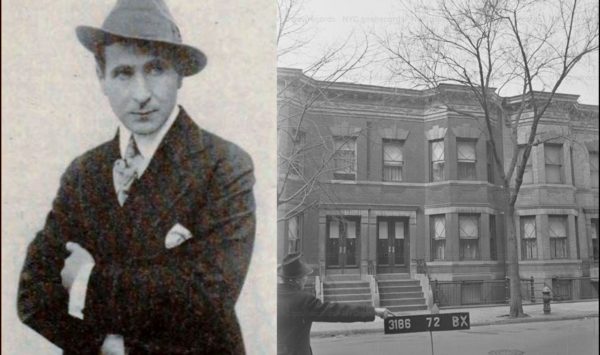
******************************************************************************************************************************** Brownstone Detectives investigates the history of our clients’ homes. The story you are about to read was composed from research conducted in the course of one of those investigations. Do you know the history of YOUR house? ******************************************************************************************************************************** In 1921, a “picture actor” by the name of Paul W. Panzer had gone broke. Panzer, recently flush with cash, had filed a “voluntary petition in bankruptcy” for liabilities totaling approximately $2,500. The debts appeared to be to a number of sources – a loan to a recently formed Long Beach production company of which Panzer was a trustee, money loaned to him and several other “film people” (possibly also to the same production company), as well as, amongst others, a loan that was endorsed by two very well-known and successful actors of the time, Sheldon Lewis and King Baggot (Baggot, an international movie star, was referred to – at various times – as “King of the Movies,” “The Most Photographed Man in the World” and “The Man Whose Face Is As Familiar As The Man In The Moon”). In the petition, Panzer, gave his address as “2257 Walton avenue,” where he rented a 2-story and basement rowhouse and, according to the 1920 Federal Census, lived there with his wife, their 8-year-old daughter, and their 6-year-old son. Panzer’s bankruptcy was certainly a low-point for the actor who rose to fame just half a decade earlier as the infamous villain of the smash 1914 serial silent film, The Perils of Pauline, a […]